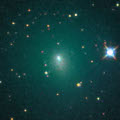
|
Brightening rapidly. Now it is 8.3 mag (Sept. 15, Toni Scarmato). This apparition is best condition. It will approach to the earth down to 0.12 A.U. in October, and brighten up to 5 mag. It will be visible with naked eyes. In the Northern Hemisphere, it keeps observable all through this apparition until 2011 June when it fades down to 17 mag. In the Southern Hemisphere, it becomes unobservable temporarily from late September to mid October. But then it keeps observable in good condition.
Date(TT) R.A. (2000) Decl. Delta r Elong. m1 Best Time(A, h)
Sept.18 23 23.67 47 16.3 0.265 1.194 130 8.3 23:36 (180, 77)
Sept.25 23 55.24 51 34.0 0.219 1.154 129 7.6 23:42 (180, 73)
|
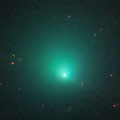
|
Now it is so bright as 8.8 mag (Sept. 5, Juan Jose Gonzalez). It will be fading after this, but it will be visible visually until December.
Date(TT) R.A. (2000) Decl. Delta r Elong. m1 Best Time(A, h)
Sept.18 1 37.29 -18 39.2 0.682 1.620 147 10.1 1:51 ( 0, 36)
Sept.25 1 33.43 -19 32.1 0.706 1.654 150 10.4 1:20 ( 0, 36)
|
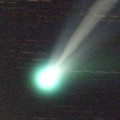
|
Appearing in the morning sky in the Southern Hemisphere. However, no observations have been reported since the perihelion passage, although it must be very bright. It approached to the sun down to 0.4 A.U. in July, and was expected to reach up to 2-3 mag. But actually, it brightened only up to 5 mag at best. It will keep observable while fading after this in the Southern Hemisphere. In the Northern Hemisphere, it will never be observable again.
Date(TT) R.A. (2000) Decl. Delta r Elong. m1 Best Time(A, h)
Sept.18 10 23.41 -37 41.9 2.263 1.684 43 11.0 4:19 (301,-24)
Sept.25 10 34.80 -41 41.4 2.345 1.798 45 11.4 4:25 (307,-22)
|
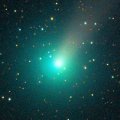
|
It brightened up to 7.9 mag in April and May (May 5, Juan Jose Gonzalez). Now it is fading. But it is still bright as 10.9 mag (Sept. 17, Jakub Cerny). It keeps observable for a long time until when it fades out in the Northern Hemisphere. It will be visible visually until December. It is not observable in the Southern Hemisphere.
Date(TT) R.A. (2000) Decl. Delta r Elong. m1 Best Time(A, h)
Sept.18 8 13.58 51 2.9 2.625 2.389 65 12.0 4:19 (230, 43)
Sept.25 8 10.76 50 54.3 2.586 2.460 71 12.2 4:25 (230, 49)
|

|
Observable in the evening sky in the Southern Hemisphere. Fading rapidly. It was bright as 7.7 mag on Aug. 17 (Chris Wyatt), but it is 11.0 mag now (Sept. 10, Alexandre Amorim). It will keep observable while fading rapidly after this in the Southern Hemisphere. It is not observable in the Northern Hemisphere.
Date(TT) R.A. (2000) Decl. Delta r Elong. m1 Best Time(A, h)
Sept.18 14 44.34 -24 11.8 1.245 1.004 51 12.8 19:28 ( 57, 3)
Sept.25 15 25.76 -26 38.6 1.345 1.117 54 13.7 19:17 ( 52, 5)
|
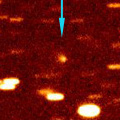
|
It brightened up to 15.5 mag in January (Jan. 31, C. Rinner, F. Kugel). It is not observable now. The condition of this apparition is bad. It has not been observable at all around the maximum brightness. It will appear in the morning sky in October.
Date(TT) R.A. (2000) Decl. Delta r Elong. m1 Best Time(A, h)
Sept.18 9 57.07 2 22.1 2.453 1.611 25 13.0 4:19 (269, 3)
Sept.25 10 14.00 0 17.2 2.468 1.651 28 13.2 4:25 (273, 5)
|
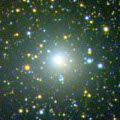
|
It reached up to 7.7 mag in last summer (2009 Aug. 13, Chris Wyatt). It is fading now. It has already faded down to 13.2 mag (Sept. 6, Chris Wyatt). In the Southern Hemisphere, it keeps observable for a long time after this. In the Northern Hemisphere, it will never be observable again.
Date(TT) R.A. (2000) Decl. Delta r Elong. m1 Best Time(A, h)
Sept.18 17 14.54 -47 18.1 5.061 5.109 87 13.4 19:28 ( 20, 3)
Sept.25 17 13.51 -47 12.0 5.224 5.156 80 13.6 19:17 ( 23, 2)
|
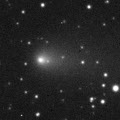
|
Now it is 11.7 mag (Aug. 6, Juan Jose Gonzalez). It will keep 12-13 mag until autumn. It is observable in excellent condition in the Southern Hemisphere. It locates somewhat low in the Northern Hemisphere.
Date(TT) R.A. (2000) Decl. Delta r Elong. m1 Best Time(A, h)
Sept.18 20 33.36 -32 40.3 2.002 2.722 126 13.5 20:44 ( 0, 22)
Sept.25 20 34.71 -32 11.7 2.093 2.739 120 13.7 20:18 ( 0, 23)
|

|
Already bright as 12.8 mag and visible visually (Aug. 20, Juan Jose Gonzalez). It is expected to keep so bright as 6-8 mag for a long time from 2011 to 2012, and to be observable in good condition in the Northern Hemisphere. In 2010, it is observable in good condition in the Southern Hemisphere while brightening slowly. It locates low in the Northern Hemisphere, but it keeps observable until the end of 2010.
Date(TT) R.A. (2000) Decl. Delta r Elong. m1 Best Time(A, h)
Sept.18 22 49.16 -38 16.0 4.619 5.445 141 14.2 22:59 ( 0, 17)
Sept.25 22 40.73 -38 11.1 4.612 5.383 136 14.1 22:23 ( 0, 17)
|

|
Now it is unobservable. It will appear in the morning sky again in October.
Date(TT) R.A. (2000) Decl. Delta r Elong. m1 Best Time(A, h)
Sept.18 10 34.54 5 32.3 7.185 6.231 16 14.2 4:19 (261, -3)
Sept.25 10 39.17 4 59.7 7.147 6.232 22 14.2 4:25 (266, 3)
|
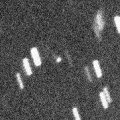
|
Now it is 14.6 mag, much brighter than originally expected (Sept. 1, A. Novichonok, L. Elenin). It keeps observable in good condition from autumn to next spring. It will brighten up to 13 mag and will be visible visually.
Date(TT) R.A. (2000) Decl. Delta r Elong. m1 Best Time(A, h)
Sept.18 7 46.69 25 41.6 3.629 3.263 60 15.0 4:19 (265, 42)
Sept.25 7 48.38 24 18.1 3.488 3.234 67 14.9 4:25 (271, 48)
|
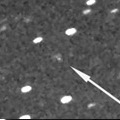
|
The condition in this apparition is bad. It keeps unobservable for a while. In the Southern Hemisphere, it will appear in the morning sky at 12.5 mag in February, then it keeps observable while fading gradually. In the Northern Hemisphere, it is not observable until when it fades down to 15 mag.
Date(TT) R.A. (2000) Decl. Delta r Elong. m1 Best Time(A, h)
Sept.18 12 10.65 5 42.1 2.871 1.882 8 15.2 19:28 (104,-10)
Sept.25 12 26.27 3 47.3 2.837 1.845 6 14.9 19:17 (103,-11)
|
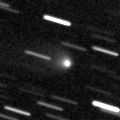
|
It is already bright as 13.8 mag and visible visually (Sept. 10, Chris Wyatt). It will be observable at 13-14 mag for a long time from 2011 to 2012.
Date(TT) R.A. (2000) Decl. Delta r Elong. m1 Best Time(A, h)
Sept.18 20 31.83 -2 47.9 5.956 6.679 132 15.1 20:42 ( 0, 52)
Sept.25 20 26.95 -3 20.9 6.020 6.647 125 15.1 20:10 ( 0, 52)
|
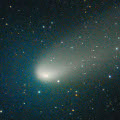
|
It reached up to 9.2 mag in March (Mar. 20, Marco Goiato). Now it is fading. It has already faded down to 14.8 mag (Sept. 1, Hidetaka Sato). It will be getting lower in the evening sky, and will be unobservable in November.
Date(TT) R.A. (2000) Decl. Delta r Elong. m1 Best Time(A, h)
Sept.18 16 17.16 -19 2.1 2.606 2.468 70 15.2 19:28 ( 45, 21)
Sept.25 16 28.82 -19 37.1 2.727 2.509 66 15.4 19:17 ( 46, 20)
|
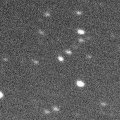
|
Now it is 14.8 mag (June 23, Hidetaka Sato). It keeps bright as 14-15 mag for a long time after this until 2013. It is observable in good condition in the Southern Hemisphere. However, it is not observable in the Northern Hemisphere. Despite of the brightness, few observations have been reported recently.
Date(TT) R.A. (2000) Decl. Delta r Elong. m1 Best Time(A, h)
Sept.18 14 30.31 -48 16.4 6.840 6.434 62 15.3 19:28 ( 41,-15)
Sept.25 14 33.75 -48 35.2 6.892 6.408 57 15.3 19:17 ( 42,-17)
|
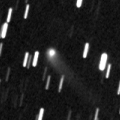
|
Now it is bright as 14.2 mag and visible visually (Sept. 5, Sandor Szabo). It keeps observable at 14-15 mag for a long time in 2010. It locates in good condition in the Northern Hemisphere. It locates low, and will be unobservable in October in the Southern Hemisphere.
Date(TT) R.A. (2000) Decl. Delta r Elong. m1 Best Time(A, h)
Sept.18 17 35.91 37 38.4 4.439 4.512 87 15.3 19:28 (105, 70)
Sept.25 17 40.52 36 54.8 4.482 4.511 85 15.3 19:17 (103, 67)
|
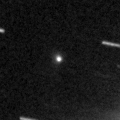
|
Now it is 14.0 mag, much brighter than expected and visible visually (Sept. 10, Alan Hale). In the Northern Hemisphere, it will be observable at 14-15 mag in good condition from autumn to winter. In the Southern Hemisphere, it will be unobservable until 2011 spring.
Date(TT) R.A. (2000) Decl. Delta r Elong. m1 Best Time(A, h)
Sept.18 12 47.82 71 52.1 3.066 2.892 70 15.5 19:28 (159, 31)
Sept.25 13 25.98 72 7.5 2.968 2.857 73 15.4 19:17 (159, 33)
|
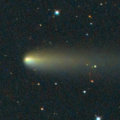
|
It brightened up to 9.5 mag in January (Jan. 13, Juan Jose Gonzalez). Now it is fading. It has already faded down to 14.6 mag (Sept. 5, Sandor Szabo). It will be too faint to see visually soon. It will be fainter than 18 mag at the end of 2010. In the Northern Hemisphere, it keeps observable for a long time, although it will be getting lower gradually. It is not observable in the Southern Hemisphere.
Date(TT) R.A. (2000) Decl. Delta r Elong. m1 Best Time(A, h)
Sept.18 15 43.27 41 17.6 4.598 4.304 66 16.0 19:28 (115, 48)
Sept.25 15 51.58 40 4.7 4.682 4.361 65 16.1 19:17 (114, 46)
|

|
It keeps 16 mag until the end of 2010. It keeps observable in good condition in the Southern Hemisphere. But it is not observable at all in the Northern Hemisphere. It must have been bright, but no observations have been reported since May.
Date(TT) R.A. (2000) Decl. Delta r Elong. m1 Best Time(A, h)
Sept.18 8 29.56 -50 49.4 2.984 2.746 66 16.3 4:19 (324,-13)
Sept.25 8 29.75 -54 1.5 2.931 2.742 69 16.2 4:25 (330,-12)
|
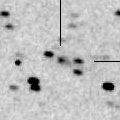
|
Recovered as bright as expected. Now it is 16.5 mag (Aug. 11, Hidetaka Sato). It is observable at 15.5 mag in good condition from autumn to winter. It locates somewhat low in the Southern Hemisphere.
Date(TT) R.A. (2000) Decl. Delta r Elong. m1 Best Time(A, h)
Sept.18 6 0.07 17 18.9 1.968 2.128 84 16.4 4:19 (297, 59)
Sept.25 6 10.66 18 13.2 1.889 2.125 89 16.3 4:25 (304, 64)
|
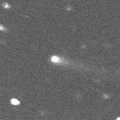
|
It was observed at 16 mag from late 2009 to early 2010. It has already passed the perihelion, however, it tends to be brightest after the perihelion passage. It will be observable at 16 mag again in good condition from late 2010 to early 2011.
Date(TT) R.A. (2000) Decl. Delta r Elong. m1 Best Time(A, h)
Sept.18 9 19.53 14 52.1 4.139 3.394 37 16.4 4:19 (264, 18)
Sept.25 9 28.21 14 7.2 4.088 3.406 41 16.4 4:25 (268, 22)
|
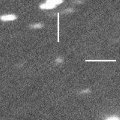
|
Now it is 17.4 mag (Sept. 3, La Sagra). It keeps 17 mag for a long time from 2009 to 2012. It is observable in good condition in the Northern Hemisphere. It locates somewhat low in the Southern Hemisphere.
Date(TT) R.A. (2000) Decl. Delta r Elong. m1 Best Time(A, h)
Sept.18 2 6.23 20 57.7 7.404 8.175 137 17.0 2:20 ( 0, 76)
Sept.25 2 1.18 20 44.9 7.320 8.166 145 16.9 1:48 ( 0, 76)
|
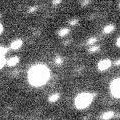
|
Now it is 18.0 mag (Aug. 20, Jean-Francois Soulier). It was observed at 17 mag in summer and autumn in 2009. It is observable again at 17 mag in summer and autumn also in 2010. But actually, it is fainter than expected now. It locates in good condition in the Northern Hemisphere, but somewhat low in the Southern Hemisphere.
Date(TT) R.A. (2000) Decl. Delta r Elong. m1 Best Time(A, h)
Sept.18 3 25.58 22 53.1 2.033 2.680 119 17.1 3:39 ( 0, 78)
Sept.25 3 25.98 22 35.5 1.978 2.700 126 17.1 3:12 ( 0, 78)
|
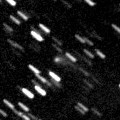
|
Now it is 17.8 mag (Aug. 25, Ken-ichi Kadota). A bit fainter than this ephemeris. In the Northern Hemisphere, it keeps observable while fading gradually, and it will be fainter than 18 mag in November. In the Southern Hemisphere, it will never be observable again in this apparition.
Date(TT) R.A. (2000) Decl. Delta r Elong. m1 Best Time(A, h)
Sept.18 7 45.17 65 56.3 2.780 2.717 75 17.2 4:19 (209, 46)
Sept.25 8 5.91 66 49.9 2.771 2.766 79 17.3 4:25 (207, 47)
|

|
It will pass the perihelion on Nov. 25. In the Northern Hemisphere, it is observable until early November when it brightens up to 16 mag, and after mid December while fading from 16 mag. It will not be observable in the Southern Hemisphere.
Date(TT) R.A. (2000) Decl. Delta r Elong. m1 Best Time(A, h)
Sept.18 7 36.28 26 32.1 1.554 1.425 63 17.6 4:19 (266, 45)
Sept.25 7 59.26 25 6.3 1.407 1.338 64 17.3 4:25 (269, 46)
|

|
Now it is 16.9 mag (Aug. 11, Ken-ichi Kadota). Now it is fading. It will be fainter than 18 mag in November. It locates in excellent condition in the Southern Hemisphere, but it locates low in the Northern Hemisphere.
Date(TT) R.A. (2000) Decl. Delta r Elong. m1 Best Time(A, h)
Sept.18 20 30.59 -33 41.3 2.555 3.243 125 17.4 20:42 ( 0, 21)
Sept.25 20 30.90 -33 23.2 2.639 3.247 119 17.5 20:14 ( 0, 22)
|
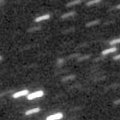
|
Now it is 17.0 mag (Sept. 1, F. Garcia). It keeps 17-18 mag for a long time until 2011 summer. It will be getting lower after this and will be unobservable in late autumn. But it will be observable again in 2011. The condition in 2011 will be good in the Northern Hemisphere, but it locates low in the Southern Hemisphere.
Date(TT) R.A. (2000) Decl. Delta r Elong. m1 Best Time(A, h)
Sept.18 18 3.80 11 20.9 3.790 4.007 95 17.4 19:28 ( 40, 61)
Sept.25 17 59.17 10 57.8 3.896 3.996 88 17.5 19:17 ( 48, 58)
|

|
Now it is 17.4 mag (Aug. 16, Ken-ichi Kadota). It has already passed the perihelion, however, it tends to be brightest after the perihelion passage. In the Northern Hemisphere, it will be observable at 17.5 mag in good condition until the end of 2010. It locates extremely low in the Southern Hemisphere.
Date(TT) R.A. (2000) Decl. Delta r Elong. m1 Best Time(A, h)
Sept.18 7 49.38 33 25.4 2.268 2.011 62 17.5 4:19 (255, 44)
Sept.25 8 4.38 32 23.3 2.226 2.032 65 17.4 4:25 (258, 48)
|

|
Now it is 17.9 mag (Aug. 20, C. Rinner, F. Kugel). It is observable at 17.5 mag in good condition from summer to autumn in the Northern Hemisphere. It locates somewhat low in the Southern Hemisphere.
Date(TT) R.A. (2000) Decl. Delta r Elong. m1 Best Time(A, h)
Sept.18 1 3.31 35 36.2 0.961 1.833 137 17.5 1:17 (180, 89)
Sept.25 1 3.18 35 11.9 0.934 1.837 143 17.5 0:50 (180, 90)
|

|
It has not been observed in this apparition yet, but it must have been already bright as 17-18 mag. Now it locates in very good condition in the Southern Hemisphere. But it will be getting lower after this, and will be unobservable in January. In the Northern Hemisphere, it will be observable in good condition while fading gradually from 16 mag after 2011 summer.
Date(TT) R.A. (2000) Decl. Delta r Elong. m1 Best Time(A, h)
Sept.18 20 9.92 -36 8.4 2.146 2.795 120 17.6 20:21 ( 0, 19)
Sept.25 20 9.16 -35 58.3 2.189 2.754 114 17.6 19:53 ( 0, 19)
|
|
![]()
 29P/Schwassmann-Wachmann 1
29P/Schwassmann-Wachmann 1 C/2010 B1 ( Cardinal )
C/2010 B1 ( Cardinal ) 9P/Tempel 1
9P/Tempel 1 C/2006 S3 ( LONEOS )
C/2006 S3 ( LONEOS ) 81P/Wild 2
81P/Wild 2 C/2009 F4 ( McNaught )
C/2009 F4 ( McNaught ) C/2008 FK75 ( Lemmon-Siding Spring )
C/2008 FK75 ( Lemmon-Siding Spring ) C/2009 Y1 ( Catalina )
C/2009 Y1 ( Catalina ) C/2007 Q3 ( Siding Spring )
C/2007 Q3 ( Siding Spring ) C/2010 A4 ( Siding Spring )
C/2010 A4 ( Siding Spring ) 240P/2010 P1 ( NEAT )
240P/2010 P1 ( NEAT ) 203P/2008 R4 ( Korlevic )
203P/2008 R4 ( Korlevic ) C/2008 S3 ( Boattini )
C/2008 S3 ( Boattini ) 219P/2009 H1 ( LINEAR )
219P/2009 H1 ( LINEAR ) 126P/IRAS
126P/IRAS (3200) Phaethon
(3200) Phaethon 215P/2009 B5 ( NEAT )
215P/2009 B5 ( NEAT ) C/2009 UG89 ( Lemmon )
C/2009 UG89 ( Lemmon ) 241P/2010 P2 ( LINEAR )
241P/2010 P2 ( LINEAR ) 236P/2010 K1 ( LINEAR )
236P/2010 K1 ( LINEAR ) 164P/Christensen
164P/Christensen![]()























